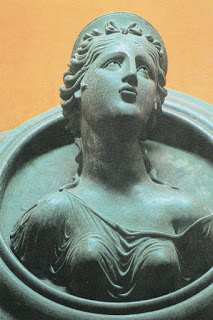“The National Museum of Damascus: Banias
Among the countless Classical artifacts exhumed in southern Syria is this beautiful bronze bust of a goddess from the 2nd century C.E. -imago clipeata- measuring 39 cm in diameter and 36 cm in height. Discovered in Banias in 1965, it has proudly graced Damascus’ National Museum ever since.”
http://bornindamascus.blogspot.com/2017/08/the-national-museum-of-damascus-banias.html
“Thus did Odysseus address Nausicaa, daughter of King Alcinous (Homer, the Odyssey Book VI) but the lovely lady represented in this bust is an authentic immortal goddess and her Olympian abode is none other than the National Museum of Damascus.
Acquired from Banias (the occupied Golan) in 1965, this bronze imago clipeata (from Latin: portrait on a round shield) is about 39 cm in diameter and dates from the second half of the second century C.E.
Banias is an ancient city located on the slopes of Mount Hermon in the vicinity of the springs of the River Jordan. Its original name derives from the Greek Shepherd god, Pan (whence Paneas or Banias). It also is called Dan (the Old Testament) as well as Caesarea Philippi in the Bible (Matthew 16:13 and Mark 8:27 KJV). It was re-baptized as Neronias under Nero but that name was short lived.
The site was captured by Israel in 1967 and has been under occupation ever since.”
Thomas M. Weber; Sculptures from Roman Syria
Wernersche Verlagsgesellschaft. Worms 2006


